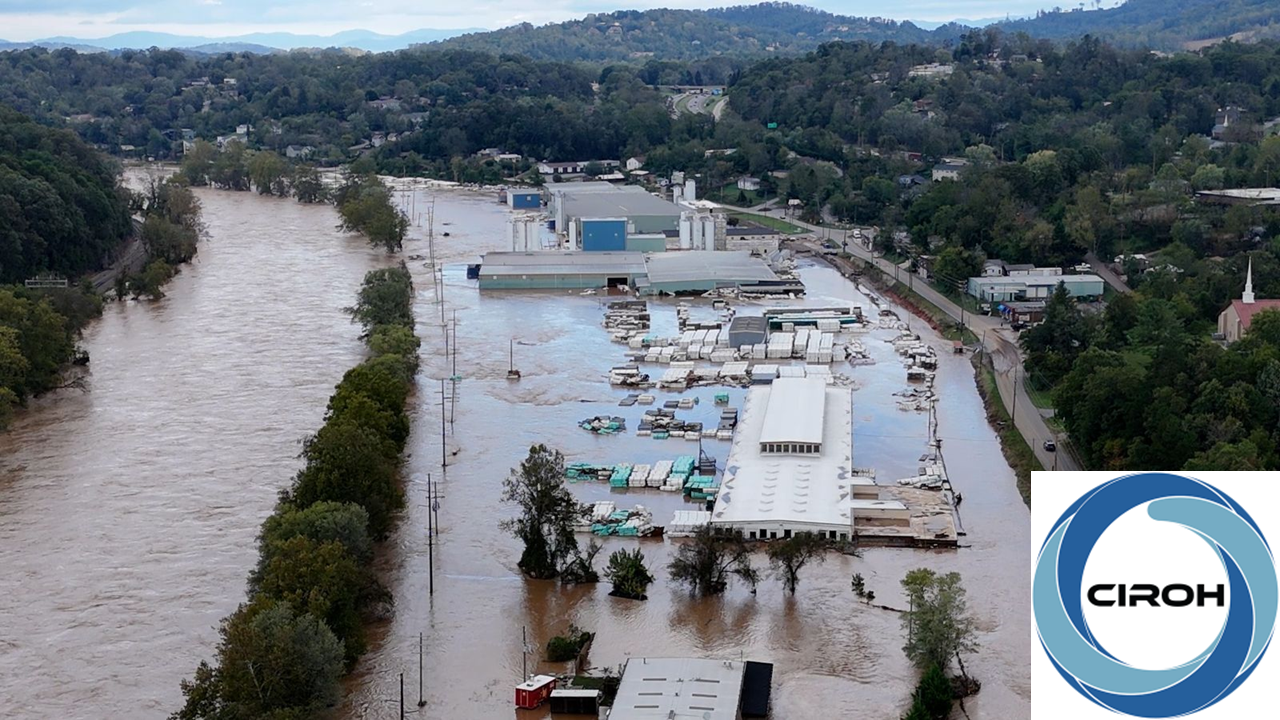Problem Statement
In the United States, extreme flooding events are becoming increasingly frequent and severe, posing significant risks to communities and infrastructure. For instance, Hurricane Helene, an event that exceeded all expectations, caused extensive flooding in Asheville and its surrounding areas. The unprecedented nature of this event highlighted the critical need for effective tools to assess flood risks and identify high-risk areas.
Flood inundation maps, such as those produced by FEMA and the National Water Model (NWM), are essential for visualizing the extent and impacts of flooding. These maps provide valuable insights into flood-prone areas, enabling a better understanding of vulnerabilities within communities, critical facilities, and infrastructure. The insights derived from these maps support flood risk management strategies and mitigation of the impacts of future extreme weather events.
Module Overview
This module focuses on flood inundation mapping and its application in vulnerability assessment. Learners will explore different flood mapping approaches using FEMA flood products and the National Water Model(NWM) to assess flood exposure and high risk facilities. It consists of the following sections:
Section 1: Introduction
Section 1.2: Flood Inundation Mapping Using FEMA and NWM products
Section 1.3: Evaluation of Flood Inundation Mapping
Section 1.4: Identifying High-Risk Facilities Using Flood Extent Maps
Topics Covered
- Fundamentals of flood inundation mapping, including key concepts, tools, and data sources
- FEMA flood products and cross-sectional analysis, including identification of the 1% annual chance flood and calculation of flood depth
- Visualization of flood inundation using FEMA and NWM data through guided exercises in Google Colab
- Comparison of flood map outputs from different data sources to explore variability and limitations
- Flood risk assessment using inundation maps, including identification of vulnerable facilities and emergency planning
Learning Objectives
By the end of this module, learners will be able to:
1- Identify a 100-year flood hazard area near their home using the NFHL Viewer. (Bloom’s Level: Apply)
2- Extract and record cross-section information including regulatory flood elevation and stream bed elevation. (Bloom’s Level: Apply)
3- Calculate the 1% annual chance flood depth at a selected cross section using FEMA flood profile data. (Bloom’s Level: Analyze)
4- Access and execute a Google Colab Notebook to visualize flood inundation maps from FEMA and NWM for Hurricane Helene. (Bloom’s Level: Apply)
5- Interpret and describe visual differences in flood extent between FEMA and NWM flood maps using generated maps. (Bloom’s Level: Analyze)
6- Visualize FEMA and NWM flood inundation shapefiles in Google Earth Pro or another GIS platform. (Bloom’s Level: Understand)
7- Identify critical facilities affected by FEMA and NWM flood inundation maps. (Bloom’s Level: Apply)
8- Classify the flood risk level (High, Medium, Low) of each facility using a structured decision guide. (Bloom’s Level: Analyze)
9- Compose a concise emergency response memo communicating high-risk facility findings and recommendations. (Bloom’s Level: Create)
10- Evaluate the effectiveness of FEMA vs. NWM flood maps for emergency planning by reflecting on map differences and facility-level discrepancies. (Bloom’s Level: Evaluate)
This will be accomplished through activities within each section. Results from each activity will be recorded in specified results templates. The results templates can be found at the beginning of the final culminating learning activity.
Suggested Implementation
This module is designed for use in a 3-hour professional training session for emergency managers, floodplain administrators, or other operational staff involved in flood planning and response. It includes four structured activities that guide learners through interpreting FEMA flood products, visualizing flood extents using FEMA and NWM data, and assessing flood risk for critical facilities.
The module is best delivered in a computer lab or virtual setting where participants can follow along using Google Earth Pro and Google Colab. All datasets and tools are pre-configured to minimize setup time and technical barriers. I recommend dividing the session into brief instructional segments followed by hands-on exercises, allowing time for participants to apply each concept immediately. The module requires no prior experience with coding or GIS and is designed to be practical, scenario-based, and directly relevant to operational decision-making.
Course Authors
Saide Zand
Graduate Student, The University of Alabama
Saide Zand is a second-year PhD student at the University of Alabama, specializing in coastal hydrology and flood risk assessment. As a member of the Coastal Hydrology Lab, Saide's research focuses on leveraging machine learning for flood inundation mapping, enhancing the accuracy and efficiency of hindcast flood mapping.Saide is honored to be part of the Cooperative Institute for Research to Operations in Hydrology (CIROH) and contributes to the "Physics-Informed Machine Learning for Compound Flood Mapping" project. This research integrates hydrodynamic modeling and physical principles with machine learning to improve flood mapping capabilities, particularly in complex coastal environments.
Email address: szand@crimson.ua.edu
Dr. Sushree Swagatika Swain
Postdoctoral Scholar, Scripps Institute of Oceanography UCSD
Dr. Sushree is a Postdoctoral Scholar at the Scripps Institute of Oceanography, University of California San Diego. Her research specializes in the quantitative analysis and probabilistic risk assessment of hydro-climatic compound extremes, with specific focus on characterizing the multi-variate dependencies and cascading effects of complex extremes on hydrologic ecosystems and the communities. She integrates data-driven hydrological modeling, climate model simulations, statistical modeling and machine learning within risk assessment frameworks to advance complex extreme predictions. Her work aims to improve disaster preparedness and climate resilience policy through decision-support systems. As a part of the Cooperative Institute for Research to Operations in Hydrology (CIROH) initiated HydroLearn Hackathon Program, Dr. Sushree contributes to the Compound Flood Mapping and Vulnerability Analysis project, advancing research in hydrological hazards and risk mitigation.
Email address: ssswain@ucsd.edu
Target Audience
This course is designed for:
- Operational hydrologists involved in flood forecasting and emergency management
Expected Effort
Learners should expect to dedicate approximately 3 hours to complete this module, including lectures, hands-on exercises, and case study analysis.
Course Sharing and Adaptation
This module, Flood Inundation Mapping and Risk Assessment for Operational Planning, is available for adaptation and reuse through HydroLearn.
It was adapted from a previous academic module to better serve the needs of operational personnel, including emergency planners and water managers.
To export or adapt this module for your own training or instructional use, click the "Export Link" at the top right of this page.
You will need a HydroLearn instructor account to do this. First, sign up at hydrolearn.org,
then go to studio.hydrolearn.org and request course creation permissions.
Adapted From
This module is adapted from the original HydroLearn module:
Flood Inundation Mapping Using Machine Learning for Sustainable vs. Resilient Design
Significant changes were made to tailor the content for operational flood response training:
- Section 2 was revised to replace deep learning applications with a focus on National Water Model (NWM) flood products for inundation mapping and visualization.
- Section 4 was fully restructured. The original content on “Decision Making for Hydraulic Design” was replaced with a new section: “Identifying High-Risk Facilities Using Flood Extent Maps,” focusing on practical risk assessment using FEMA and NWM data.
These major modifications led to several supporting changes, including:
- New and updated Learning Activities (2, 3, and 4)
- Rewritten Learning Objectives across the module
- Revised summaries, instructions, and assessment components throughout
The adapted module maintains the spirit of the original while refocusing it toward emergency planning and operational decision-making.
Acknowledgement
This project received funding under award NA22NWS4320003 by National Oceanic and Atmospheric Administration (NOAA) Cooperative Institute Program to the Cooperative Institute for Research on Hydrology (CIROH) through the University of Alabama. The statements, findings, conclusions, and recommendations are those of the author(s) and do not necessarily reflect the opinions of NOAA.
Recommended Citation
Swain, S. S., Zand, S. (2025). Flood Inundation Mapping And High Risk Facility Identification. CIROH. https://edx.hydrolearn.org/courses/course-v1:CIROH_HydroLearn+OP_080+2025/about


